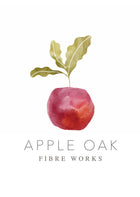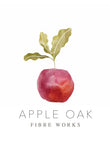Getting Ready to Sow by Tristan Lienhard
Seed collection for 2024 variety trials ~ grouped by provenance
It's been a busy winter for us at AppleOak in terms of getting ready to carry out our Dye Plant variety trials. Since last September I have been searching gene banks, conservation organizations, seed suppliers and individuals for different varieties; 4 main dye plants, which can be grown here in Ireland:
Isatis tinctoria ~ Woad
Reseda luteola ~ Weld
Rubia tinctorum ~ Madder
Persicaria tinctoria ~ Japanese Indigo
The origins of these variety trials came from my time working as the head gardener at the Irish Seed Savers Association (ISSA), where we ran a collaboration with AppleOak to grow Woad, Weld and Madder for seed. During this project we grew 3 varieties of woad; Tewksbury, Birmingham and an unknown variety which ISSA had in their seed bank. In the first year of the collaboration, we harvested the 3 varieties of woad and dyed silk scarves with them, keeping each variety separate. The difference in colour results from each variety was quite remarkable.
I have since moved on from ISSA, to work for AppleOak full time in order develop the growing of colours for the company, both for dye material and seed production. As we have decided to become a seed supplier of dye plants, we felt it was important to start this new venture by researching the varieties, which we will use for our future seed production.
As it turns out sourcing dye seeds was more of a journey than anticipated. Through hours of internet searches, emails, phone calls and call outs on social platforms, we have managed to source 21 varieties of Woad; ranging from an individual in Canada to a number of dyers and suppliers from around Europe as well as botanical Gardens in Hungary and a bazaar in South West Tajikistan through various gene banks.
With Weld we sourced 13 varieties, originating from Bishops Court County Down, to southern Spain and the botanical gardens in Basel, along with a number of varieties of unknown provenance through conservation organisations. Madder was yet more difficult to source, but we managed to find 10 varieties mostly from Gatersleben gene bank, a number of dye gardens around France and our own root cuttings from our collaboration with ISSA. Japanese Indigo was a late addition to the trials but we managed to source 6 varieties mainly from France and Germany.
The trials will involve analyzing each of the varieties for productivity, dye content and suitability for seed production in the Irish climate. For productivity we will grow a 3.5m x 1.2m plot (45 plants) of each of the varieties and weighing each harvest, while for dye content we will use the dye material harvested in a standardised dye recipe. To explore the varieties for suitability for seed production, we will document the timing of seed maturation and analyse seedling health and vigour.
I have built my propagation table for the project and had hoped to sow the seeds this week, but with such a wet and cold spring so far, and the forecast for this week predicting another drop in temperatures, I have decided to hold off for another week. I am very much looking forward to getting started though. To be continued..........here







Thank you Veronica, that is very kind of you! :)
Fascinating & admirable work that you are doing – Ireland is lucky to have you two. Thankyou !
Hinterlassen Sie einen Kommentar